Economic Impact of Recent Reforms in Australian Education Sector
VerifiedAdded on 2020/03/04
|8
|1360
|64
Report
AI Summary
This report analyzes recent reforms in the Australian education sector, focusing on the proposed increase in university fees and stricter student loan repayment schedules. It examines the economic concepts of demand and the impact of the 2007 global recession on government funding for education. The analysis considers the perspectives of students, universities, parents, and the government, highlighting the potential negative consequences of the reforms, particularly for students from low-income families. The report suggests alternative reforms, such as leveraging information technology to reduce costs and make education more affordable. It concludes that the proposed changes could reduce demand for higher education, emphasizing the need to maintain affordable tuition fees and flexible loan repayment schemes to ensure access to education for all students.
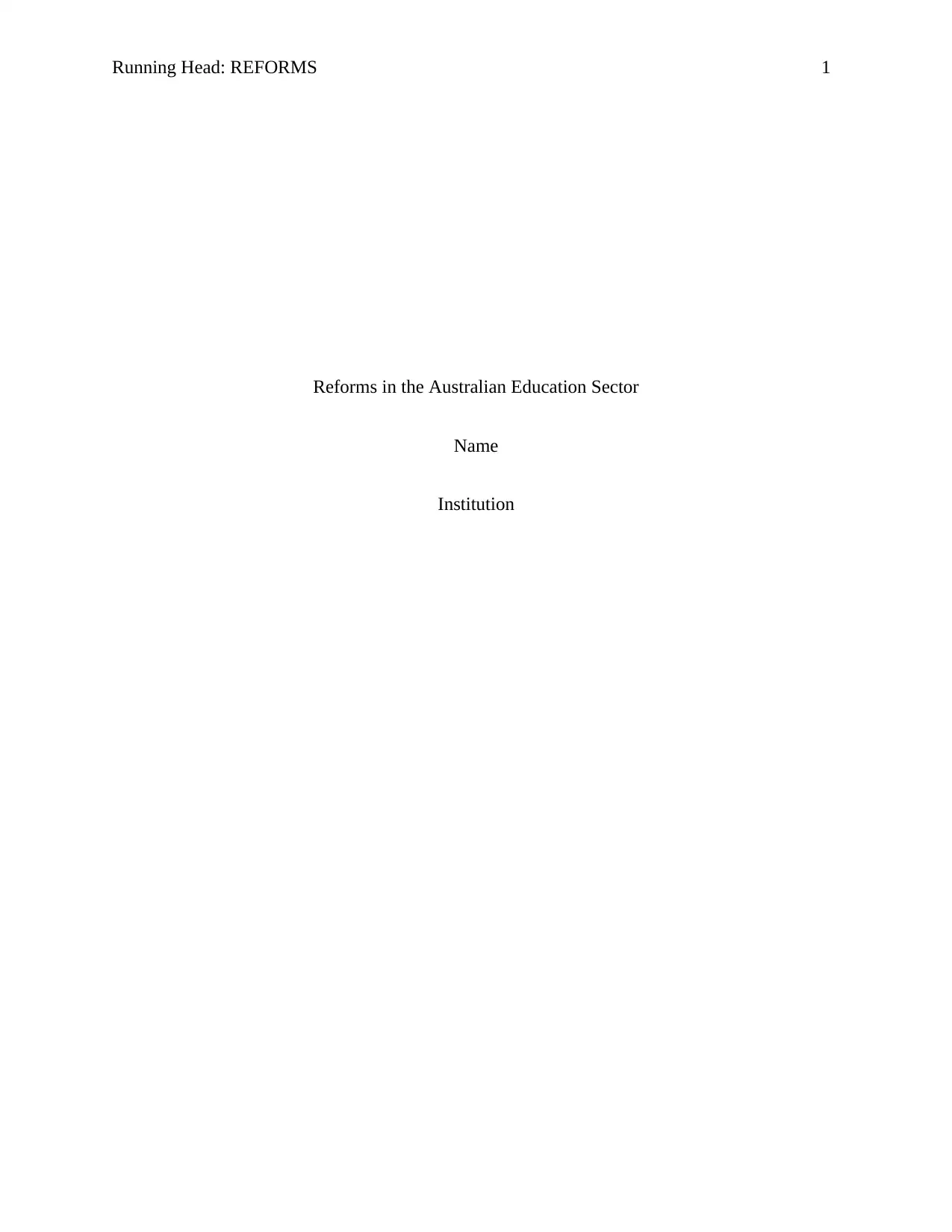
Running Head: REFORMS 1
Reforms in the Australian Education Sector
Name
Institution
Reforms in the Australian Education Sector
Name
Institution
Paraphrase This Document
Need a fresh take? Get an instant paraphrase of this document with our AI Paraphraser
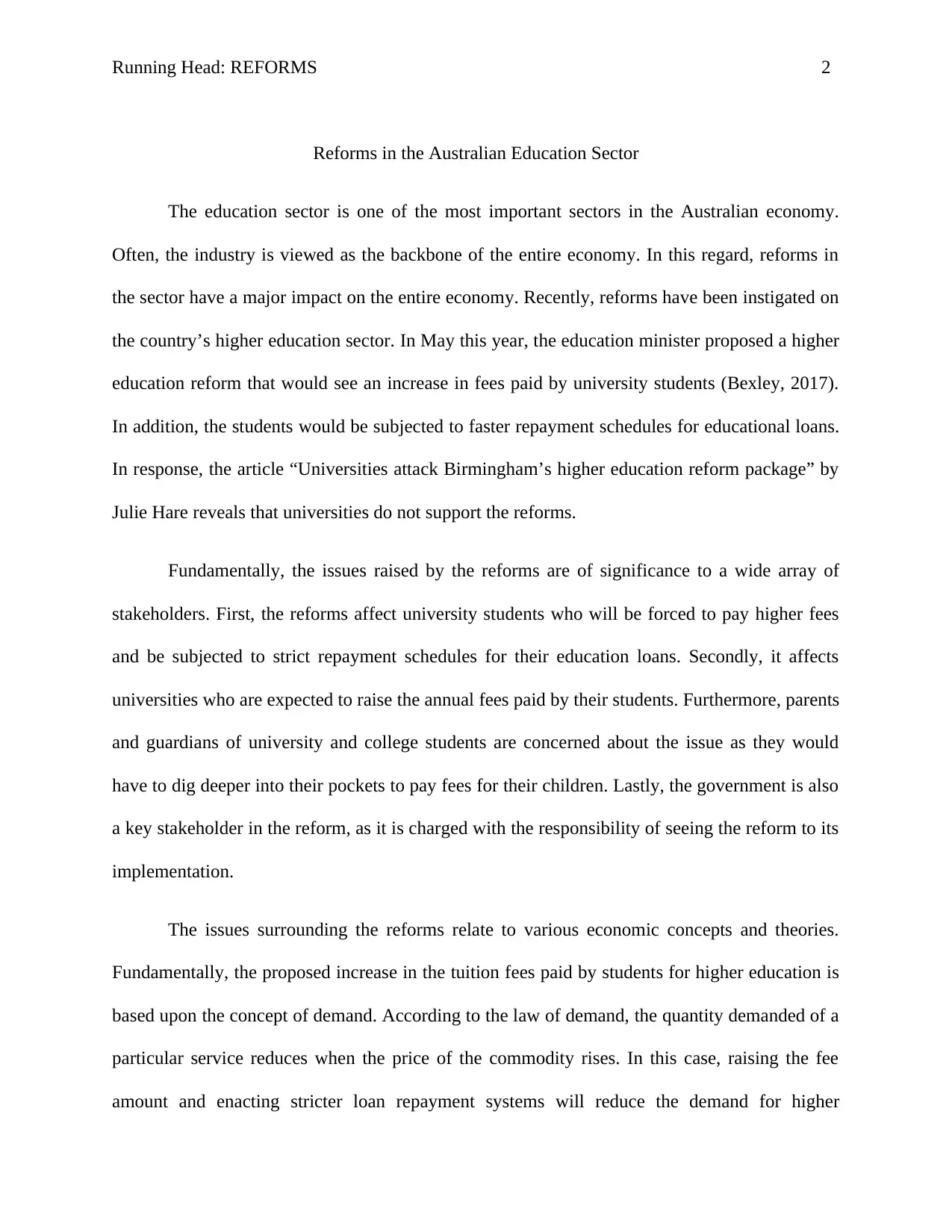
Running Head: REFORMS 2
Reforms in the Australian Education Sector
The education sector is one of the most important sectors in the Australian economy.
Often, the industry is viewed as the backbone of the entire economy. In this regard, reforms in
the sector have a major impact on the entire economy. Recently, reforms have been instigated on
the country’s higher education sector. In May this year, the education minister proposed a higher
education reform that would see an increase in fees paid by university students (Bexley, 2017).
In addition, the students would be subjected to faster repayment schedules for educational loans.
In response, the article “Universities attack Birmingham’s higher education reform package” by
Julie Hare reveals that universities do not support the reforms.
Fundamentally, the issues raised by the reforms are of significance to a wide array of
stakeholders. First, the reforms affect university students who will be forced to pay higher fees
and be subjected to strict repayment schedules for their education loans. Secondly, it affects
universities who are expected to raise the annual fees paid by their students. Furthermore, parents
and guardians of university and college students are concerned about the issue as they would
have to dig deeper into their pockets to pay fees for their children. Lastly, the government is also
a key stakeholder in the reform, as it is charged with the responsibility of seeing the reform to its
implementation.
The issues surrounding the reforms relate to various economic concepts and theories.
Fundamentally, the proposed increase in the tuition fees paid by students for higher education is
based upon the concept of demand. According to the law of demand, the quantity demanded of a
particular service reduces when the price of the commodity rises. In this case, raising the fee
amount and enacting stricter loan repayment systems will reduce the demand for higher
Reforms in the Australian Education Sector
The education sector is one of the most important sectors in the Australian economy.
Often, the industry is viewed as the backbone of the entire economy. In this regard, reforms in
the sector have a major impact on the entire economy. Recently, reforms have been instigated on
the country’s higher education sector. In May this year, the education minister proposed a higher
education reform that would see an increase in fees paid by university students (Bexley, 2017).
In addition, the students would be subjected to faster repayment schedules for educational loans.
In response, the article “Universities attack Birmingham’s higher education reform package” by
Julie Hare reveals that universities do not support the reforms.
Fundamentally, the issues raised by the reforms are of significance to a wide array of
stakeholders. First, the reforms affect university students who will be forced to pay higher fees
and be subjected to strict repayment schedules for their education loans. Secondly, it affects
universities who are expected to raise the annual fees paid by their students. Furthermore, parents
and guardians of university and college students are concerned about the issue as they would
have to dig deeper into their pockets to pay fees for their children. Lastly, the government is also
a key stakeholder in the reform, as it is charged with the responsibility of seeing the reform to its
implementation.
The issues surrounding the reforms relate to various economic concepts and theories.
Fundamentally, the proposed increase in the tuition fees paid by students for higher education is
based upon the concept of demand. According to the law of demand, the quantity demanded of a
particular service reduces when the price of the commodity rises. In this case, raising the fee
amount and enacting stricter loan repayment systems will reduce the demand for higher
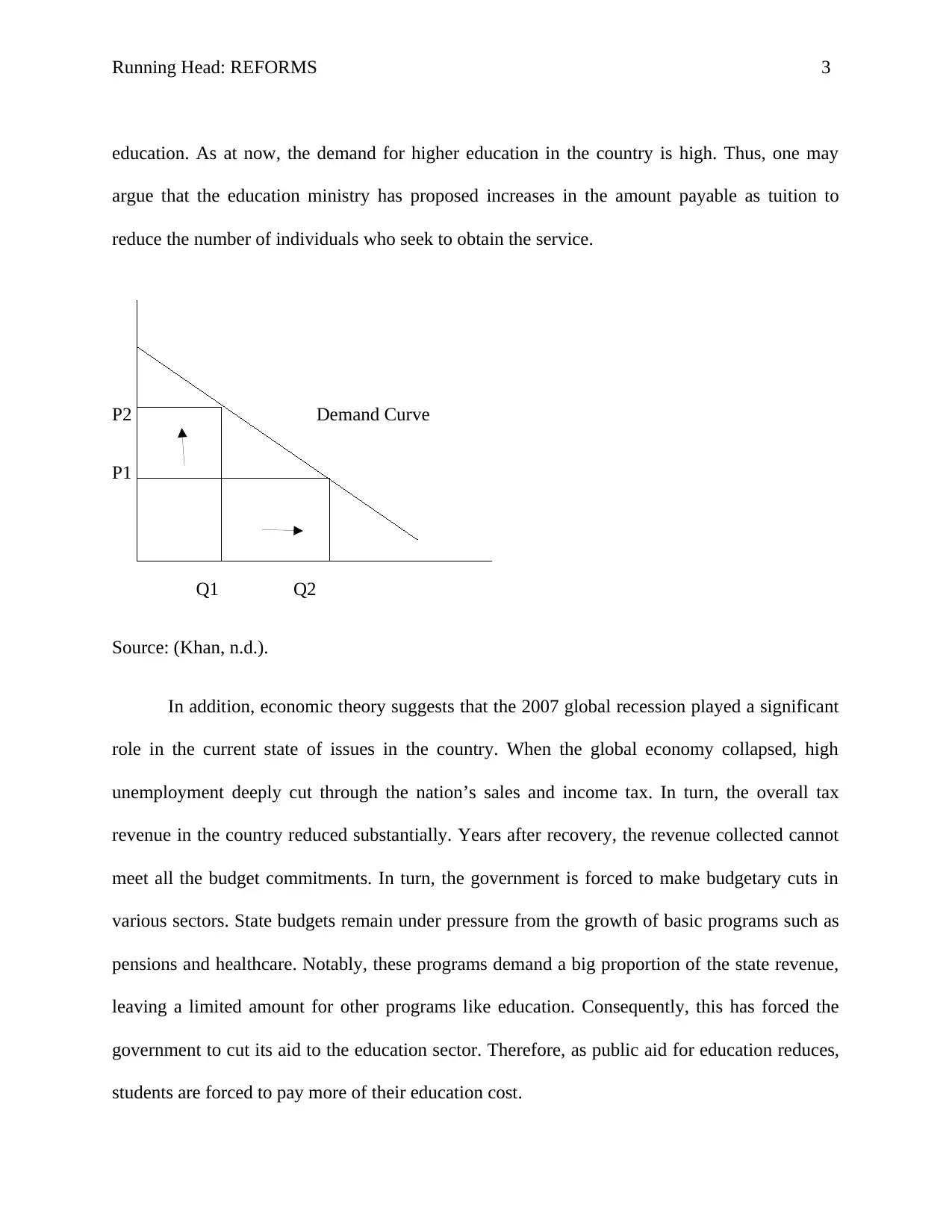
Running Head: REFORMS 3
education. As at now, the demand for higher education in the country is high. Thus, one may
argue that the education ministry has proposed increases in the amount payable as tuition to
reduce the number of individuals who seek to obtain the service.
P2 Demand Curve
P1
Q1 Q2
Source: (Khan, n.d.).
In addition, economic theory suggests that the 2007 global recession played a significant
role in the current state of issues in the country. When the global economy collapsed, high
unemployment deeply cut through the nation’s sales and income tax. In turn, the overall tax
revenue in the country reduced substantially. Years after recovery, the revenue collected cannot
meet all the budget commitments. In turn, the government is forced to make budgetary cuts in
various sectors. State budgets remain under pressure from the growth of basic programs such as
pensions and healthcare. Notably, these programs demand a big proportion of the state revenue,
leaving a limited amount for other programs like education. Consequently, this has forced the
government to cut its aid to the education sector. Therefore, as public aid for education reduces,
students are forced to pay more of their education cost.
education. As at now, the demand for higher education in the country is high. Thus, one may
argue that the education ministry has proposed increases in the amount payable as tuition to
reduce the number of individuals who seek to obtain the service.
P2 Demand Curve
P1
Q1 Q2
Source: (Khan, n.d.).
In addition, economic theory suggests that the 2007 global recession played a significant
role in the current state of issues in the country. When the global economy collapsed, high
unemployment deeply cut through the nation’s sales and income tax. In turn, the overall tax
revenue in the country reduced substantially. Years after recovery, the revenue collected cannot
meet all the budget commitments. In turn, the government is forced to make budgetary cuts in
various sectors. State budgets remain under pressure from the growth of basic programs such as
pensions and healthcare. Notably, these programs demand a big proportion of the state revenue,
leaving a limited amount for other programs like education. Consequently, this has forced the
government to cut its aid to the education sector. Therefore, as public aid for education reduces,
students are forced to pay more of their education cost.
⊘ This is a preview!⊘
Do you want full access?
Subscribe today to unlock all pages.

Trusted by 1+ million students worldwide
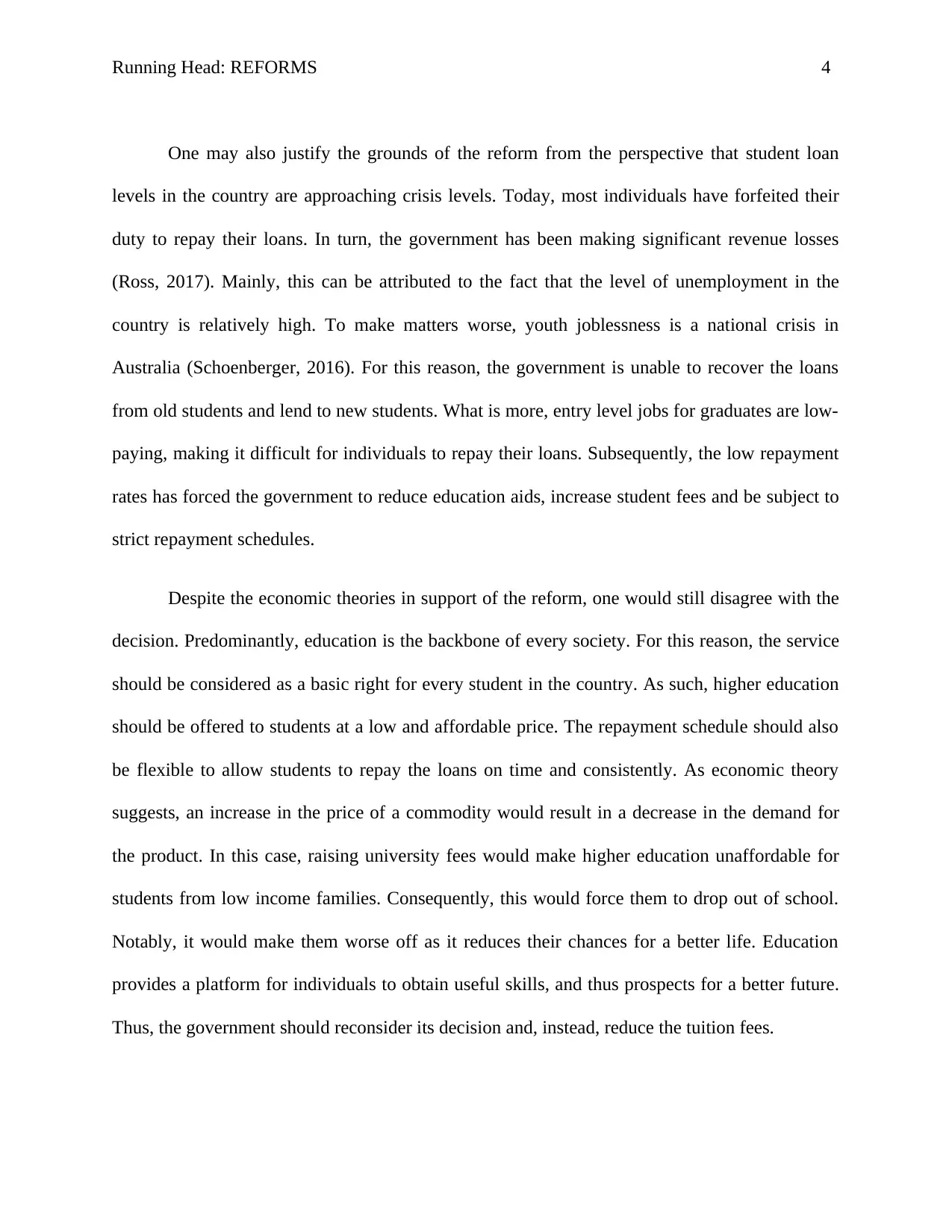
Running Head: REFORMS 4
One may also justify the grounds of the reform from the perspective that student loan
levels in the country are approaching crisis levels. Today, most individuals have forfeited their
duty to repay their loans. In turn, the government has been making significant revenue losses
(Ross, 2017). Mainly, this can be attributed to the fact that the level of unemployment in the
country is relatively high. To make matters worse, youth joblessness is a national crisis in
Australia (Schoenberger, 2016). For this reason, the government is unable to recover the loans
from old students and lend to new students. What is more, entry level jobs for graduates are low-
paying, making it difficult for individuals to repay their loans. Subsequently, the low repayment
rates has forced the government to reduce education aids, increase student fees and be subject to
strict repayment schedules.
Despite the economic theories in support of the reform, one would still disagree with the
decision. Predominantly, education is the backbone of every society. For this reason, the service
should be considered as a basic right for every student in the country. As such, higher education
should be offered to students at a low and affordable price. The repayment schedule should also
be flexible to allow students to repay the loans on time and consistently. As economic theory
suggests, an increase in the price of a commodity would result in a decrease in the demand for
the product. In this case, raising university fees would make higher education unaffordable for
students from low income families. Consequently, this would force them to drop out of school.
Notably, it would make them worse off as it reduces their chances for a better life. Education
provides a platform for individuals to obtain useful skills, and thus prospects for a better future.
Thus, the government should reconsider its decision and, instead, reduce the tuition fees.
One may also justify the grounds of the reform from the perspective that student loan
levels in the country are approaching crisis levels. Today, most individuals have forfeited their
duty to repay their loans. In turn, the government has been making significant revenue losses
(Ross, 2017). Mainly, this can be attributed to the fact that the level of unemployment in the
country is relatively high. To make matters worse, youth joblessness is a national crisis in
Australia (Schoenberger, 2016). For this reason, the government is unable to recover the loans
from old students and lend to new students. What is more, entry level jobs for graduates are low-
paying, making it difficult for individuals to repay their loans. Subsequently, the low repayment
rates has forced the government to reduce education aids, increase student fees and be subject to
strict repayment schedules.
Despite the economic theories in support of the reform, one would still disagree with the
decision. Predominantly, education is the backbone of every society. For this reason, the service
should be considered as a basic right for every student in the country. As such, higher education
should be offered to students at a low and affordable price. The repayment schedule should also
be flexible to allow students to repay the loans on time and consistently. As economic theory
suggests, an increase in the price of a commodity would result in a decrease in the demand for
the product. In this case, raising university fees would make higher education unaffordable for
students from low income families. Consequently, this would force them to drop out of school.
Notably, it would make them worse off as it reduces their chances for a better life. Education
provides a platform for individuals to obtain useful skills, and thus prospects for a better future.
Thus, the government should reconsider its decision and, instead, reduce the tuition fees.
Paraphrase This Document
Need a fresh take? Get an instant paraphrase of this document with our AI Paraphraser
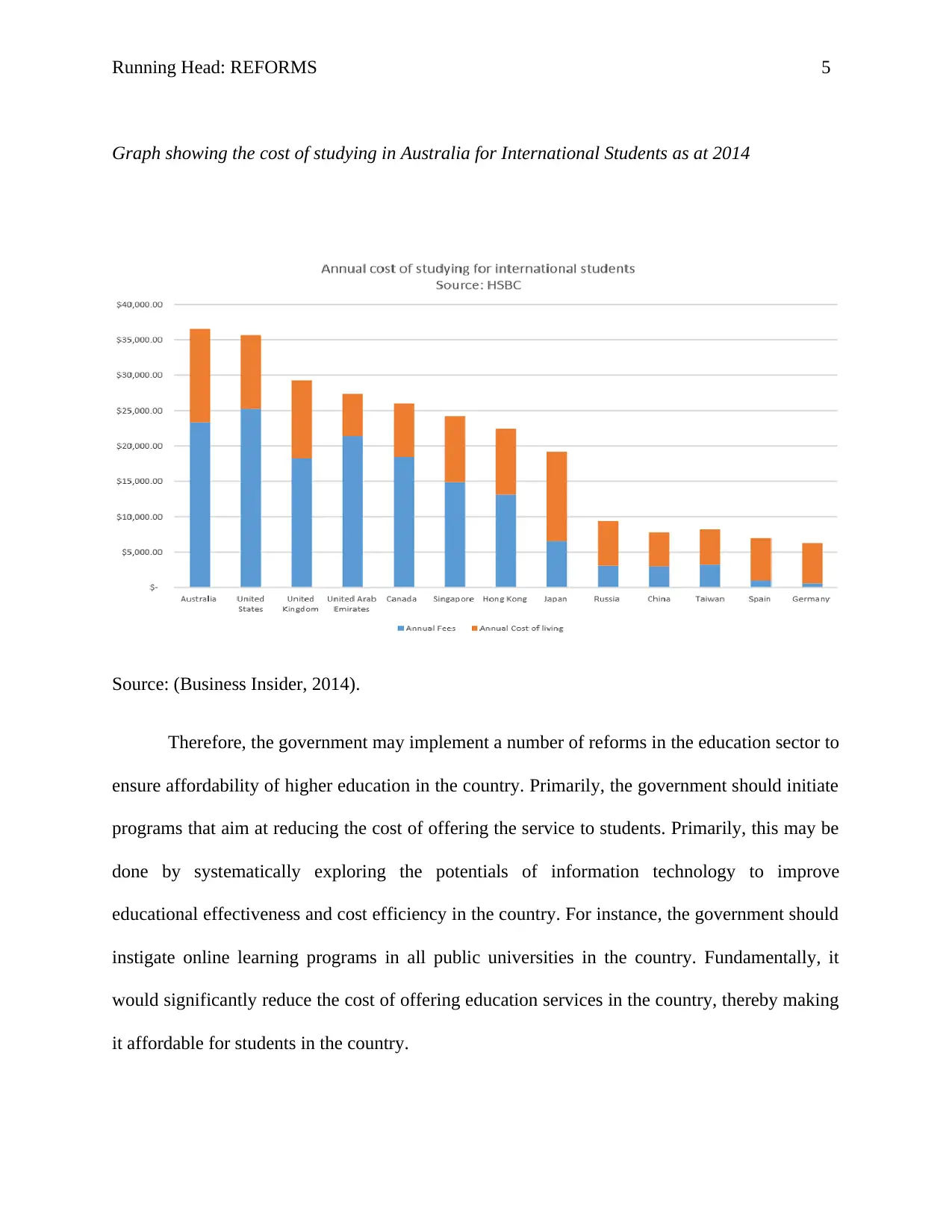
Running Head: REFORMS 5
Graph showing the cost of studying in Australia for International Students as at 2014
Source: (Business Insider, 2014).
Therefore, the government may implement a number of reforms in the education sector to
ensure affordability of higher education in the country. Primarily, the government should initiate
programs that aim at reducing the cost of offering the service to students. Primarily, this may be
done by systematically exploring the potentials of information technology to improve
educational effectiveness and cost efficiency in the country. For instance, the government should
instigate online learning programs in all public universities in the country. Fundamentally, it
would significantly reduce the cost of offering education services in the country, thereby making
it affordable for students in the country.
Graph showing the cost of studying in Australia for International Students as at 2014
Source: (Business Insider, 2014).
Therefore, the government may implement a number of reforms in the education sector to
ensure affordability of higher education in the country. Primarily, the government should initiate
programs that aim at reducing the cost of offering the service to students. Primarily, this may be
done by systematically exploring the potentials of information technology to improve
educational effectiveness and cost efficiency in the country. For instance, the government should
instigate online learning programs in all public universities in the country. Fundamentally, it
would significantly reduce the cost of offering education services in the country, thereby making
it affordable for students in the country.
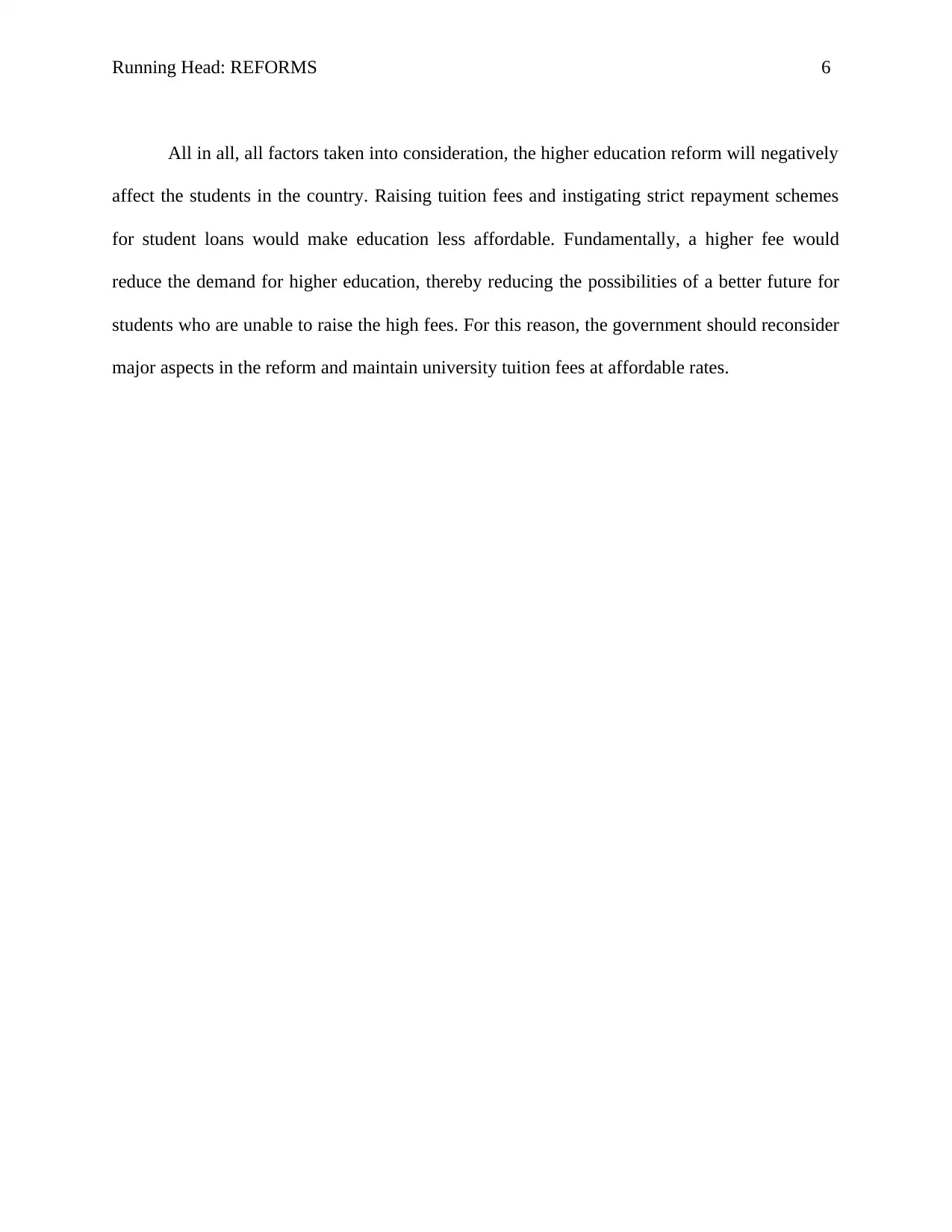
Running Head: REFORMS 6
All in all, all factors taken into consideration, the higher education reform will negatively
affect the students in the country. Raising tuition fees and instigating strict repayment schemes
for student loans would make education less affordable. Fundamentally, a higher fee would
reduce the demand for higher education, thereby reducing the possibilities of a better future for
students who are unable to raise the high fees. For this reason, the government should reconsider
major aspects in the reform and maintain university tuition fees at affordable rates.
All in all, all factors taken into consideration, the higher education reform will negatively
affect the students in the country. Raising tuition fees and instigating strict repayment schemes
for student loans would make education less affordable. Fundamentally, a higher fee would
reduce the demand for higher education, thereby reducing the possibilities of a better future for
students who are unable to raise the high fees. For this reason, the government should reconsider
major aspects in the reform and maintain university tuition fees at affordable rates.
⊘ This is a preview!⊘
Do you want full access?
Subscribe today to unlock all pages.

Trusted by 1+ million students worldwide
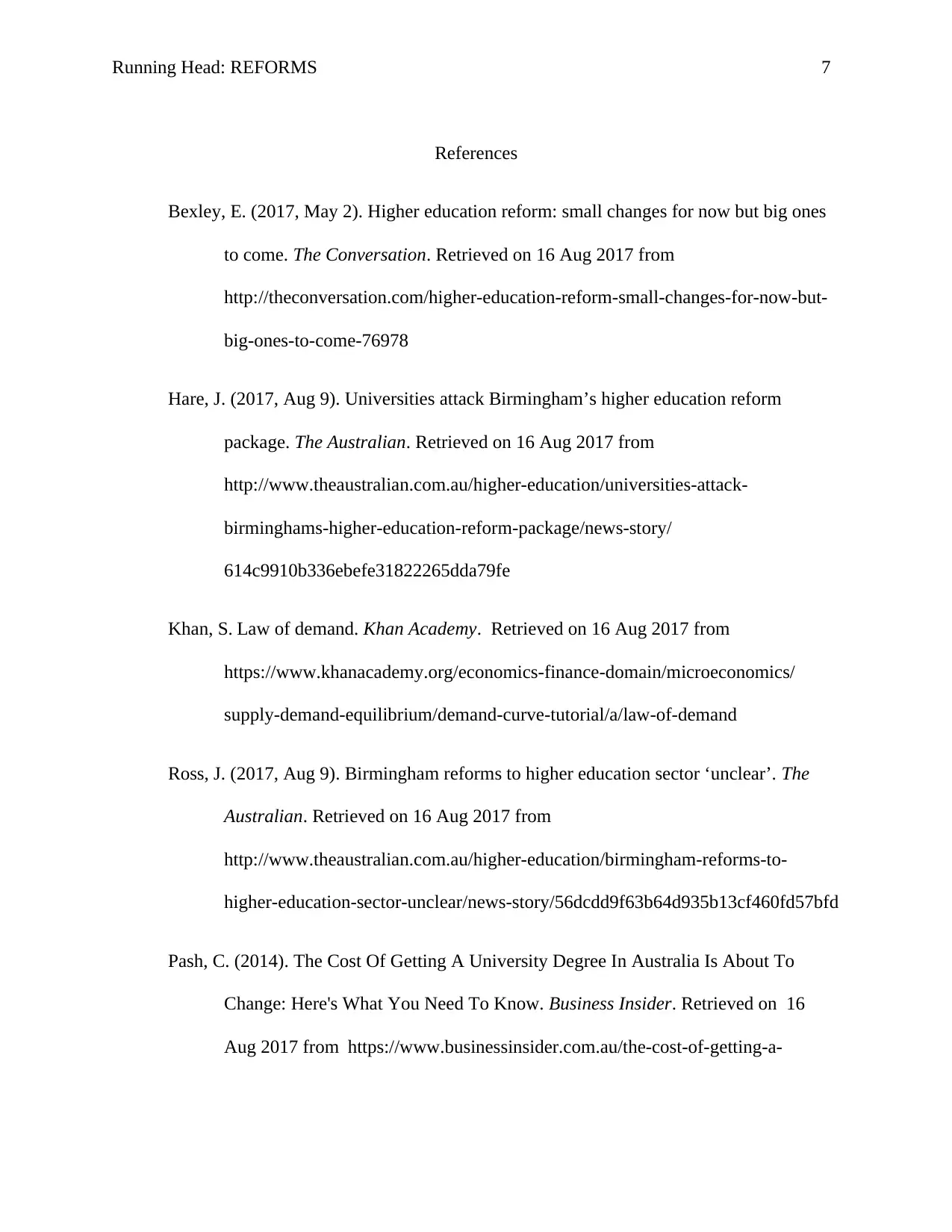
Running Head: REFORMS 7
References
Bexley, E. (2017, May 2). Higher education reform: small changes for now but big ones
to come. The Conversation. Retrieved on 16 Aug 2017 from
http://theconversation.com/higher-education-reform-small-changes-for-now-but-
big-ones-to-come-76978
Hare, J. (2017, Aug 9). Universities attack Birmingham’s higher education reform
package. The Australian. Retrieved on 16 Aug 2017 from
http://www.theaustralian.com.au/higher-education/universities-attack-
birminghams-higher-education-reform-package/news-story/
614c9910b336ebefe31822265dda79fe
Khan, S. Law of demand. Khan Academy. Retrieved on 16 Aug 2017 from
https://www.khanacademy.org/economics-finance-domain/microeconomics/
supply-demand-equilibrium/demand-curve-tutorial/a/law-of-demand
Ross, J. (2017, Aug 9). Birmingham reforms to higher education sector ‘unclear’. The
Australian. Retrieved on 16 Aug 2017 from
http://www.theaustralian.com.au/higher-education/birmingham-reforms-to-
higher-education-sector-unclear/news-story/56dcdd9f63b64d935b13cf460fd57bfd
Pash, C. (2014). The Cost Of Getting A University Degree In Australia Is About To
Change: Here's What You Need To Know. Business Insider. Retrieved on 16
Aug 2017 from https://www.businessinsider.com.au/the-cost-of-getting-a-
References
Bexley, E. (2017, May 2). Higher education reform: small changes for now but big ones
to come. The Conversation. Retrieved on 16 Aug 2017 from
http://theconversation.com/higher-education-reform-small-changes-for-now-but-
big-ones-to-come-76978
Hare, J. (2017, Aug 9). Universities attack Birmingham’s higher education reform
package. The Australian. Retrieved on 16 Aug 2017 from
http://www.theaustralian.com.au/higher-education/universities-attack-
birminghams-higher-education-reform-package/news-story/
614c9910b336ebefe31822265dda79fe
Khan, S. Law of demand. Khan Academy. Retrieved on 16 Aug 2017 from
https://www.khanacademy.org/economics-finance-domain/microeconomics/
supply-demand-equilibrium/demand-curve-tutorial/a/law-of-demand
Ross, J. (2017, Aug 9). Birmingham reforms to higher education sector ‘unclear’. The
Australian. Retrieved on 16 Aug 2017 from
http://www.theaustralian.com.au/higher-education/birmingham-reforms-to-
higher-education-sector-unclear/news-story/56dcdd9f63b64d935b13cf460fd57bfd
Pash, C. (2014). The Cost Of Getting A University Degree In Australia Is About To
Change: Here's What You Need To Know. Business Insider. Retrieved on 16
Aug 2017 from https://www.businessinsider.com.au/the-cost-of-getting-a-
Paraphrase This Document
Need a fresh take? Get an instant paraphrase of this document with our AI Paraphraser
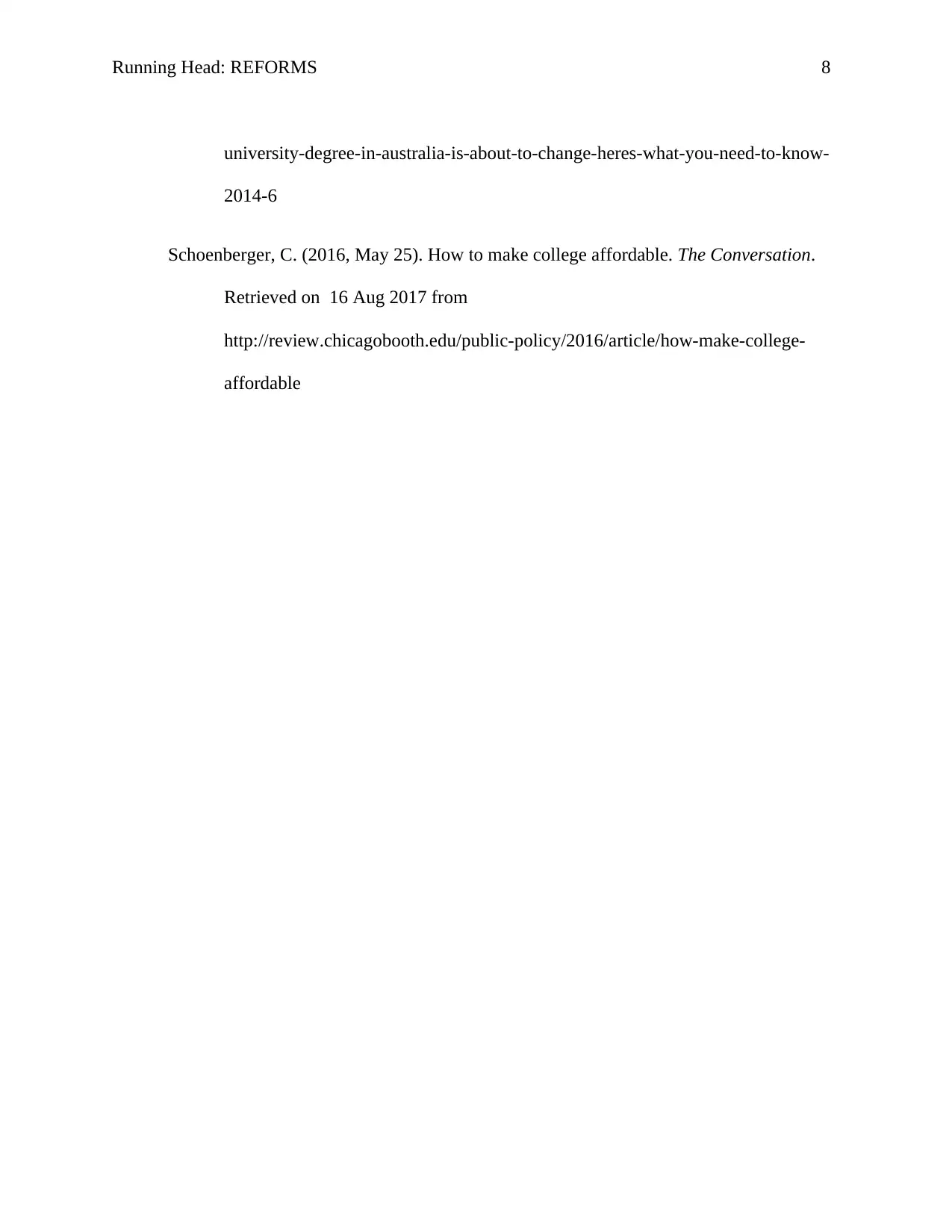
Running Head: REFORMS 8
university-degree-in-australia-is-about-to-change-heres-what-you-need-to-know-
2014-6
Schoenberger, C. (2016, May 25). How to make college affordable. The Conversation.
Retrieved on 16 Aug 2017 from
http://review.chicagobooth.edu/public-policy/2016/article/how-make-college-
affordable
university-degree-in-australia-is-about-to-change-heres-what-you-need-to-know-
2014-6
Schoenberger, C. (2016, May 25). How to make college affordable. The Conversation.
Retrieved on 16 Aug 2017 from
http://review.chicagobooth.edu/public-policy/2016/article/how-make-college-
affordable
1 out of 8
Related Documents
Your All-in-One AI-Powered Toolkit for Academic Success.
+13062052269
info@desklib.com
Available 24*7 on WhatsApp / Email
![[object Object]](/_next/static/media/star-bottom.7253800d.svg)
Unlock your academic potential
Copyright © 2020–2025 A2Z Services. All Rights Reserved. Developed and managed by ZUCOL.





